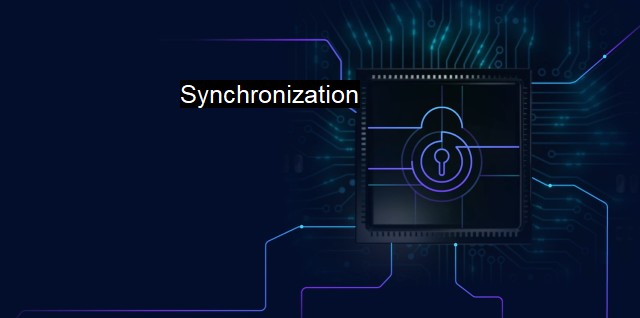What is Synchronization?
The Vital Role of Synchronization in Cybersecurity and Antivirus Programs: Ensuring Cohesive and Updated Protection Against Evolving Cyber Threats
Synchronization refers to the process of precisely coordinating or matching two or more activities, devices, or processes in time. synchronization plays a critical role in securing an organization's data and IT infrastructure. It facilitates the seamless interchange and integration of security measures and techniques across networked devices, thereby creating an in-depth protective layer against cyber threats.Cybersecurity systems primarily aim to prevent unauthorized access, use, disclosure, interruption, or destruction of information stored on digital spaces. These systems employ various mechanisms to maintain the integrity, confidentiality, and availability of information. Antivirus software is a staple component of these systems, providing a first line of defense against malicious software. This software, looped into a broader network-wide security system, prevents bits of destructive code from being executed in a network environment.
Both these securities are interconnected via synchronization. If the antivirus software detects a virus on a single device, the information is instantly shared across the entire system. As such, all devices on the network become primed to detect and mitigate the same threat. This synchronized security operates on multiple levels, significantly improving an organization's risk preparedness by joining its antivirus solution, detective controls, and other cybersecurity components.
The subsystem of communication synchronization in cybersecurity employs real-time threat detection and faster reaction times. There are cases where threats mutate and grow in complexity after invading one system. Here, synchronization aids in sharing updated threat information across protected devices. Consequently, each system gets alerted and is prepared to counter the evolving threat, ensuring that all systems' security measures are synchronized, leading to coordinated real-time responses.
This principle of interconnected security extends to cutting-edge cybersecurity technologies such as machine learning and artificial intelligence. These technologies learn from encounters with malware, gradually improving their ability to recognize and block similar threats in the future. Via synchronization, the learning from one system gets transferred to others, harnessing network synergy to significantly improve collective security intelligence.
Synchronization in cybersecurity should not be conceived of as a one-off process. Cyber threats are dynamic, with new viruses, ransomware, and other forms of malware emerging daily. Risks, therefore, introduce the need for continuous synchronization. synchronization amongst different components of an organization's cybersecurity infrastructure enables it to maintain a well-rounded perspective on potential threats.
Synchronization in the cybersecurity domain refers to the real-time coordination of various antivirus and cybersecurity mechanisms across a network. This process ensures frontline defenses are backed up by wider underlying security architecture, resulting in an organization-wide defense against cyber threats that is robust and responsive.
The effectiveness of synchronous security also involves upgrading and strengthening the software and educated usage protocols, preventing any gaps in the defense chain. This ongoing upgrade forms the dynamic nature of cybersecurity synchronization.
In an increasingly digital world, synchronization's role in cybersecurity ensures that threats detected on one system are recognized across all others. Entire networks, thus, continuously learn and adapt, fortifying their defenses in real-time. It thereby ensures resilience in the face of new and intricate cyber threats, demonstrating that synchronization is an indispensable component of 21st-century antivirus and cybersecurity operations.

Synchronization FAQs
What is synchronization in the context of cybersecurity?
Synchronization in cybersecurity refers to the process of ensuring that all devices, software, and systems in a network are updated and have the same level of protection against security threats. It involves making sure that all antivirus software is up to date and any changes are immediately propagated to all devices in the network.Why is synchronization important in cybersecurity?
Synchronization is crucial in cybersecurity because it helps to ensure consistency in security measures across the network. It ensures that all devices have the same updated virus definitions and security patches. This, in turn, helps to reduce the risk of security breaches and protects against malware and other cyber threats.How is synchronization achieved in cybersecurity?
Synchronization can be achieved through various means, including automatic updates, central server management, and manual synchronization. Automatic updates are the most common and are usually set up to occur at regular intervals. Central server management involves a central server that distributes updates and patches to all devices in the network. Manual synchronization involves manually updating each device on the network.What are the challenges of synchronization in cybersecurity?
One of the main challenges of synchronization in cybersecurity is ensuring that all devices are updated and synchronized efficiently. This can be especially difficult in large networks with many devices. Another challenge is ensuring that all devices are compatible with the latest updates and patches. In addition, the process of synchronization can be time-consuming and resource-intensive, requiring frequent updates and changes to keep up with the constantly evolving cyber threat landscape.| | A | | | B | | | C | | | D | | | E | | | F | | | G | | | H | | | I | | | J | | | K | | | L | | | M | |
| | N | | | O | | | P | | | Q | | | R | | | S | | | T | | | U | | | V | | | W | | | X | | | Y | | | Z | |
| | 1 | | | 2 | | | 3 | | | 4 | | | 7 | | | 8 | | |||||||